Breeds that were developed for a particular job.
To some extend working dog breeds represent all breeds of dogs because all canines have been developed over the years to do a job.

Some are harder workers than others and those that have been breed to keep our laps warm have a very easy job. Others have to work a bit harder, helping out on farms, pulling carts, guarding livestock and even rescuing people from icy waters.
According to the AKC, working dogs are those used for
“guarding property, pulling sleds and performing water rescues.”
One may argue that there are plenty of other breeds that are very hard workers: Consider the livestock herding breeds who work tirelessly all day to keep their herd together or the little earthdogs that rid farmers of vermin that might otherwise cause major problems.
According to the American Kennel Club, these hard workers have a category all their own (Herding, Terriers)
We have listed the Working Dog Breeds Below. However, this is an arbitrary group that varies from country to country and kennel club organization to kennel club.
Job Offerings for Working Dog Breeds

If you are a working dog, your prospects for employment are good. You will need education (training) and on the job experience. What types of jobs are open to working dog breeds?
As mentioned previously, many of these dogs were used as livestock guardians, cart pullers or rescue dogs. Many are still employed in these occupations. But nowadays, people have found new and different jobs for these dogs to perform.
Search and Rescue
Employment statistics look good for any well-trained Search and Rescue Dogs.
In this occupation, dogs work side by side with their handler to sniff out humans (either dead or alive) normally from disaster sites.
Prerequisites for the job include a keen sense of smell, robust health and the ability to work under difficult situations.
Rewards are great for those dogs that find humans alive but can be difficult for those that arrive after death has occurred.
Bomb, Drug, Tobacco Sniffing Dogs
Again, a keen sense of smell is important for these dogs.
Normally employed by law enforcement, the military, prison system and other private and public organizations, these dogs are trained to find contraband and dangerous substances and alert their handlers.
This can be a difficult job and dogs are retired early to avoid burn out from stress.
Assistance Type Work
Assistance dogs were first used as seeing eye dogs to help the blind maneuver and lead a normal life.
Today they are used in a wide variety of situations. From people with diabetes and seizure disorders, to children with autism, these dogs play a major role in the quality of life of their human.
I have met a Golden Retriever who was trained to detect her owner’s impending fit a full 30 minutes before it happened. The dog would alert her owner by pawing at her, allowing the owner time to get into a safe situation. Amazing!
War Dogs
There have been war dogs since there have been wars. Historically the biggest, strongest, and those with bravery and tenacity were used.
In modern times, the military employ dogs in mine detection and other specialized tasks. Military Working Dog is the formal term but you will also see these dogs referred to as war dogs or K9 Corps.
Characteristics of Working Dog Breeds
While diverse, this group does have some common traits:
- Intelligent
- Headstrong
- Robust and Powerful
- Independent
- Normally large breed dogs
- Need extensive training
- Some can be dangerous if not trained and socialized
- May be unsuitable for new dog owners
Best Owner for Working Dog Breeds
These dogs can make great pets for the right type of people, but in the wrong hands, they can be dangerous. What is the best type of owner for these dogs?
- Strong owners willing to take time to socialize and train
- Structured environment
- Owners willing to attend to their exercise needs
- Owners will to invest in time for grooming as some have heavy coats that require regular maintenance
Working Dog Breeds: AKC
These are the working dog breeds according to the American Kennel Club.
Akita
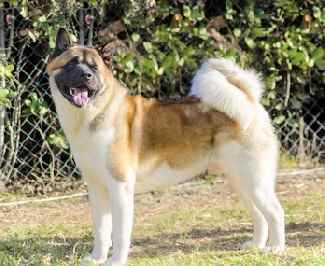
The Akita is currently used as a companion dog and a therapy dog, which seems slightly at odds with it’s reputation for aggression – but the key is in the training! This breed is normally very calm and protective of its owner.
Alaskan Malamute

The Alaskan Malamut is used for dog sled pulling, hauling freight, and the new sport of Canicross.
It is a very strong and willing runner!
Anatolian Shepherd Dog

This is a livestock guardian breed, from central Turkey. The breed line is probably very old, descended from similar dogs 6000 years ago in Mesopotamia. It used to protect sheep and livestock from wolves and bears.
This breed is virtually identical to the Kangal Dog, and some Kennel Clubs now only recognize the Kangal. (See below).
Bernese Mountain Dog

The Bernese was originally used as a general farm animal, to guard the farm, and also to pull small carts. Probably originated in Roman times. This is a BIG and powerful dog breed, while having a very calm attitude.
Black Russian Terrier

Originally bred by the state-owned Red Star Kennels for military use, the Black Russian Terrier is a mix of many breeds.
However, it is NOT a true Terrier!
Boerboel

The Boerboel was bred as a homestead guardian, farm dog, and occasionally for hunting. They have also been used to guard diamond mines. Another big and powerful dog, with an incredibly strong bite – reportedly 800 psi.
Boxer

An instinctive guardian, the Boxer is descended from hunting breeds, and was used in WW2 as a messenger dog and a guard dog. Now one of the most popular breeds in the world.
Bullmastiff

Originally bred by gamekeepers, the Bullmastiff was used to catch poachers. His size and strength combined with silence and calmness enabled him to get very close to the poacher before jumping and immobilizing him.
Cane Corso
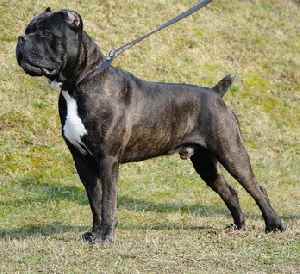
A large Italian dog, well muscled but not as bulky as most other Mastiff breeds. More athletic than an English Mastiff, but not as heavy as its cousin the Neapolitan mastiff. Mostly used nowadays to guard property, livestock and families.
Chinook
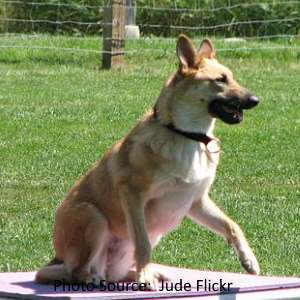
Bred originally in New Hampshire, the Chinook is basically a sled-pulling dog, but is also used in Search and Rescue work. Due to their friendly nature, many dogs of this breed are now family pets.
Doberman Pinscher

The Doberman is one of the best-known guard dogs in the world. It combines power, strength, speed and agility with aggression when required. Originally bred to protect a German tax collector!
Dogue de Bordeaux (aka. French Mastiff)

The Dogue de Bordeaux is a big dog breed from France, used for centuries as a hunting dog and a guard dog. If properly trained they are calm, confident and good with older children, although dog-on-dog aggression can be a problem.
They are big droolers, and need frequent mopping up. They don’t need a great deal of exercise, but are not really suited to apartment life as they are so big. This breed was the star of the 1989 comedy film with Tom Hanks, ‘Turner and Hooch’, which accurately depicted the breed.
Recently re-classified by the AKC into the ‘Miscellaneous’ group.
German Pinscher

Originally bred to guard coaches, with an instinct to go after rats as well, the German Pinscher is a smaller and more amiable dog compared to the Doberman!
Giant Schnauzer
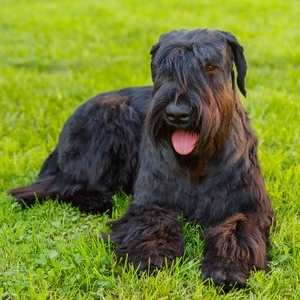
The Giant Schnauzer started out in Bavaria as a multi-purpose farm dog, gradually shifting duties to watch dog, police dog and Search-and-Rescue roles.
Great Dane

The Great Dane is the tallest dog breed, and has it’s origins in cross-breeds between English Mastiffs and Irish Wolfhounds; used in hunting boar, bear and deer. Today they are called “Gentle Giants”, and have a very calm nature.
Great Pyrenees

Known as the Pyrenean Mountain Dog outside of the USA, this is a livestock guardian dog. It was used to protect sheep herds. Nowadays it is popular as a family pet due to its calm and protective nature.
Greater Swiss Mountain Dog

Related to the Bernese Mountain Dog, this is a big-boned heavy dog used for general farm duties. Usually condidered to be the largest and oldest breed of the 4 Swiss mountain dogs.
Kangal Dog

The Kangal was bred as a livestock guardian dog, to protect flocks of sheep and goats from wolves, jackals and bears in the Anatolia region of Turkey. They are calm, confident and very protective of their flock.
They are still used today by livestock shepherds in Turkey, and more recently in Namibia and Kenya, where they have helped to reduce livestock losses to Cheetahs, and by keeping Cheetahs at a distance helped in the conservation of this big cat.
Komondor

The Komondor or Hungarian Sheepdog is a livestock guardian dog breed. Calm and affectionate with its family, it will return to its guardian roots if it senses danger. Although bred to protect its herd, it will also protect it’s owners home.
The long, shaggy coat can give the dog the appearance of having dreadlocks – it’s quite a unique dog breed!
Kuvasz

Another Hungarian livestock guardian breed, they have also been used for Royal Protection duties. Like most livestock protection dogs, they have developed their own sense of duty, and can be difficult to train. The white color helped shepherds tell them apart from marauding wolves, which are darker.
Leonberger

An excellent Search-and-Rescue dog, especially in water. The Leonberger is also a perfect family pet, although it’s huge size may be a problem for apartment dwellers. It can weigh up to 200 lbs !
Mastiff

The English Mastiff is a big, heavy, old breed type. The Mastiff was crossed with Bulldogs to create the faster, more agile Bullmastiff. The Mastiff breed is also called the English Mastiff.
Neapolitan Mastiff
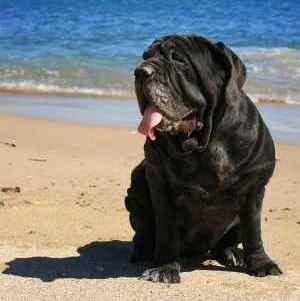
The Neapolitan Mastiff is a HUGE dog. It was bred to be a defender of properties and a guard dog, which it does extremely well due to it’s size and fearsome appearance.
Newfoundland

The Newfoundland dog breed is a fantastic swimmer, and a superb water dog. It has webbed feet, and a swimming action that is more efficient than the normal “dog paddle”. It’s sheer size and strength make it ideally suited to water rescue roles.
Portuguese Water Dog

A fascinating breed, the Portuguese Water dog was bred to herd fish into fishermen’s nets, retrieve items floating on the water surface fallen overboard from the fishing boat, and even carry items from one boat to another. Famous for Barack Obama owning not one, but two of these dogs!
Rottweiler
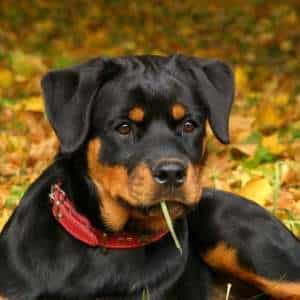
The breeding here involved herding livestock and pulling butcher’s carts to market. Nowadays they are more involved in search and rescue, as guard dogs, and as police dogs. With a strong herding and guarding instinct, they are naturally calm and assured. Problems with aggression are a result of poor upbringing and training.
Saint Bernard

Bred for rescue work in Switzerland, this is a huge, massive dog. The breed has rescued many people in trouble in the Great St. Bernard Pass. They are no longer used for mountain rescue, but are popular family dogs for those with enough space!
Samoyed

The Samoyed is also called “Smiling Sammie” because their lips turn up, making it appear like they are smiling at you, making for a picture perfect dog.
This is a breed that is adaptable, friendly, and overall outgoing and playful. Samoyeds make excellent pets for nearly everyone, considering they even get along extremely well with small children and other dogs. Sammies belong to the Working Group according to AKC and were developed to be sled dogs.
Siberian Husky

Origins: Russia
Size: Medium, to Large
Grooming: Average
Training: Average to Time Consuming
Recognition: FCI: Group 5, AKC: Working, ANKC: Utility, CKC: Working, KC: Working, NZKC: Utility, UKC: Northern Breeds
Standard Schnauzer

Tibetan Mastiff

Origins: Tibet
Size: Giant
Grooming: Time Consuming
Training: Time Consuming
Recognition: FCI: Group 2, AKC: Working, ANKC: Utility, CKC: Working, NZKC: Utility, UKC: Guardian
Working Dog Breeds from Other Kennel Clubs
The dog breeds listed and pictured above are part of the American Kennel Club Working Group. Many more are recognized around the world and are classified in the working group according to their country’s kennel club.
The Australian and New Zealand Kennel Clubs group both the working dogs and sheep dogs into one category: Working Breeds.
In the UK, these sheep dog breeds are listed separately in a group called Pastoral.
In both the US and Canada, the sheep dogs are classified in the Herding group.



